Australia’s New Icebreaker Begins Journey Home
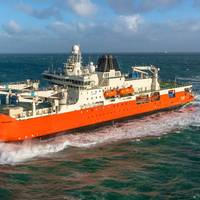
Australia’s new icebreaker, RSV Nuyina, has begun its 24,000-kilometer voyage from the Netherlands to its new home port of Hobart. The vessel will be the main lifeline to Australia’s Antarctic and sub-Antarctic research stations and the central platform of the Australian Antarctic Division's Antarctic and Southern Ocean scientific research.Construction of the ship commenced at Damen’s Galați shipyard in Romania in May 2017, and the vessel was floated out in September 2018 prior to its scheduled arrival at its home port Hobart in 2020.
Australia's New Icebreaker Starts Sea Trials
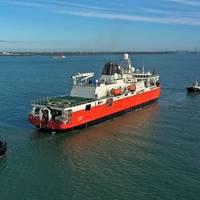
Australia’s newly completed icebreaker, RSV Nuyina, has left the Netherlands port of Vlissingen to commence trials in the North Sea.The start of the month-long sea trials, which had been pushed back due to delays stemming from the COVID-19 pandemic, will be followed by additional weeks of deepwater trials involving the Australian Antarctic Division, ship managers Serco and shipbuilder Damen. Testing of the ship’s speed, noise, propulsion systems, steering, advanced electrical…
Australia's New Icebreaker is Being Towed to the Netherlands
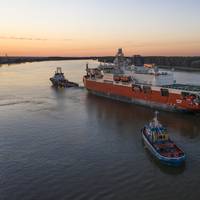
Australia’s new, nearly completed icebreaker built at Damen's Galati shipyard in Romania is traveling to the Netherlands to undergo final commissioning and sea trials that had been delayed due to the coronavirus pandemic.The Nuyina is currently under a month-long tow from Romania to the Dutch port of Vlissingen, where teams of equipment installers from Western Europe will access the new research and supply vessel (RSV) for final commissioning of essential propulsion, electrical and navigation systems…
Sea Trials for Australia's New Icebreaker Delayed Due to COVID-19
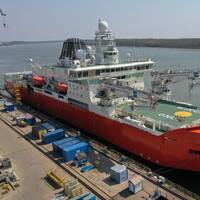
Australia's newly built Antarctic icebreaking research and supply vessel (RSV) is nearly ready to be delivered, but its sea trials have been delayed due to the coronavirus pandemic, the Australian Antarctic Division (AAD) said.Construction of the ship commenced at Damen’s Galați shipyard in Romania in May 2017, and the vessel was floated out in September 2018 prior to its scheduled arrival at its home port Hobart in 2020. But delays brought on by the COVID-19 outbreak have derailed…
Icebreaker Aurora Australis Begins Final Voyage
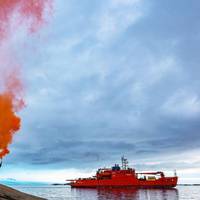
It's an end of an era for Australia’s Antarctic icebreaker RSV Aurora Australis, which departed Hobart earlier this week for its final voyage after 31 years of service to the Australian Antarctic Program.The ship’s final trip south will be a two-week voyage to resupply sub-Antarctic Macquarie Island and transport expeditioners.“The Aurora Australis has been the backbone of the Australian Antarctic Program for more than three decades, so the vessel has a special place in our history,” said Australian Antarctic Division’s General Manager of Operations, Charlton Clark.“Over its lifetime the icebr
Aus Icebreaker Nearing Completion
Preparations are ramping up for the arrival of Australia’s newest icebreaker, the RSV Nuyina. The Antarctic icebreaker is due to arrive in Hobart in 2020.RSV Nuyina will be the main lifeline to Australia’s Antarctic and sub-Antarctic research stations and the central platform of our Antarctic and Southern Ocean scientific research.Construction of the ship at Damen Shipyards in Romania commenced in May 2017, with a steel cutting ceremony, while a keel laying ceremony in August saw the first building-block of the ship consolidated in the drydock.In September 2018 the ship was floated from the dry dock to the wet dock, for the next phase of construction. Construction is expected to be completed at the end of 2019.
Damen Contracts Taylor Bros for Icebreaker Barges

Damen Schelde Naval Shipbuilding (DSNS) has selected Taylor Bros of Tasmania to supply two high powered Antarctic landing barges for Australia’s new icebreaker, the RSV Nuyina. Damen is building the vessel at its yard, Damen Shipyards Galati, in Romania for the Australian Antarctic Division (AAD). The vessel will be operated by DMS Maritime, a wholly owned subsidiary of Serco, and is an integral part of the AAD’s research program in Antarctica and the Southern Ocean. The signing ceremony was attended by the Tasmanian Minister for State Growth, Mr.
First Steel Cut for Australia's New Polar Research Ship

Marking the commencement of construction of the Damen Antarctic Supply Research Vessel (ASRV), a steel cutting ceremony has been held at Damen Shipyards Galati, Romania. Damen is constructing the ASRV for Serco Defence, a wholly owned subsidiary of Serco Australia who, in turn, signed a contract with the Australian Government last year for the delivery, operation and maintenance of the vessel. “Cutting the first steel for any vessel is always significant. However, the fact that the ASRV is such a ground-breaker makes this a very exciting moment,” said Damen Project Director Joop Noordijk.
MAN Powers Antarctic Icebreaker
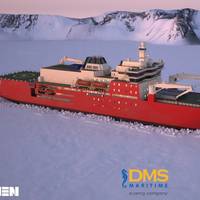
MAN Diesel & Turbo has been selected to supply the main engines to a new, icebreaking, supply-and-research vessel for the Australian Antarctic Division (AAD). The 2 × 16V32/44CR main engines – each producing 9,600 kW – were chosen for their highly reliable and fuel-efficient design that will serve in an environment with a demanding operational profile, including temperatures down to -30 degrees and extended mission times. The vessel is being procured by Serco Defence through DMS Maritime (prime contractor) and will be designed and built by Damen Shipyards Naval Shipbuilding (DSNS).
Mid-winter Air drop for Australian Antarctic Division
A Royal Australian Air Force C-17A Globemaster III strategic transport aircraft from Number 36 Squadron has successfully performed an air drop mission over Antarctica in support of the Australian Antarctic Division (AAD) building on the summer drop previously conducted in February 2016. The most recent air drop provides the Royal Australian Air Force with an all-season resupply capability and the ability to provide support to the current expeditioners on the continent. The air drop consisted of pallets containing supplies for vehicles and plant equipment, medical supplies and personal mail. The C-17A aircraft was pre-positioned at Avalon airfield to allow the crew to confirm suitable weather over Casey drop zone, approximately 70 kilometres from Wilkins Aerodrome.
Australian Icebreaker Refloated in Antarctica
Australian icebreaker Aurora Australis was refloated on Friday, two days after running aground in Antarctica while on a mission to resupply the Mawson Station, Australian Broadcasting Corp reported. The ship broke free of its moorings during a blizzard on Wednesday morning. None of the 67 expeditioners and crew on board on the ship, owned by P&O Maritime Services, were injured, according to the Australian Antarctic Division. "Expeditioners on board the Aurora Australis have been successfully transferred by barge to Mawson Station," it said. The Aurora Australis departed Australia's Tasmania island in early January to conduct research on an undersea geological formation. Ships traveling to and from Antarctica often face risky conditions.
Icebreaker Aground in Antarctica
Australia's icebreaker Aurora Australis has run ashore at Mawson Station while resupplying the Antarctic base, reports Reuters. A statement from the Australian Antarctic Division (AAD) on Wednesday confirmed 67 expeditioners and crew were on board the ship when it broke free of its mooring lines at 3.15pm during a blizzard. But no-one was injured. An AAD spokeswoman said the ship remains watertight, with no damage to the hull, but blizzard conditions are hampering a full assessment of the damage and the crew are closely monitoring the hull from inside the ship. The AAD said blizzard conditions were forecast to ease by Thursday and expedition members would be transferred to Mawson research station if winds dropped below 55km/h (34mph).
Drone Technology Aids Antarctic Ship Operations
A quadcopter drone has helped navigate the Aurora Australis through the sea ice on its annual resupply voyage to Casey station. Flown off the aft deck of the ship, the unmanned aerial vehicle (UAV) provided the crew with real-time imagery of the sea ice conditions ahead of the ship, optimising navigation decisions. Australian Antarctic Division Future Concepts Manager, Matt Filipowski, said the drone was a valuable addition to the current suite of sea ice navigation tools, which include satellite imagery and radar. “This is the first time the Australian Antarctic Division has used drone technology to assist ship operations,” Filipowski said. The proof-of-concept flights were undertaken by Civil Aviation and Safety Authority (CASA) certified company, Australian UAV.
Australia’s New Icebreaker Unveiled
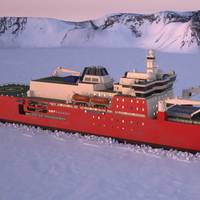
The Australian Government has provided the first look at Australia’s new icebreaker, a ship it says will offer scientists unprecedented and extended access to the Southern Ocean and Antarctica. Upon its commissioning, planned for October 2019, the custom-built ship will be home ported in Hobart, providing a modern platform for marine science research in both sea ice and open water and a moon pool for launching and retrieving remotely operated vehicles. A multi-beam bathymetric echo sounder will enable seafloor mapping…
Icebreaker Makes Emergency Return to Antarctica
The icebreaker 'Aurora Australis' was forced to return to Antarctica on Thursday, to evacuate a seriously ill Australian expedition member, just two days after leaving him on Davis Station to spend the winter in Antarctica. The Australian icebreaker will take almost two days to cover the 400 nautical miles back to Davis Station, because of sea ice conditions. When it is close enough, a helicopter will ferry the ill man to the ship. "The current weather forecast for the next 40 hours is poor, so the ship will attempt to get as close to the station as possible," the Australian Antarctic Division (AAD) said in a statement. The AAD said the man was in a serious but stable condition, without giving details of his illness.
Polar Code Afoot

The IMO is on the verge of adopting the Polar Code, something that is important and long overdue. The International Maritime Organization (IMO), a specialized agency of the United Nations, is on the verge of adopting the Polar Code. When implemented, it will establish the first mandatory rules for operation of commercial vessels in polar waters. This important step is long overdue. On 18 January 2010, the IMO adopted voluntary guidelines for ships operating in polar waters (Res. A.1024).
Australian Navy Surveys Antarctica
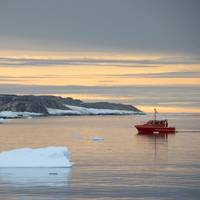
The Royal Australian Navy’s Deployable Geospatial Survey Team returned from a six-week Antarctic expedition to collect essential data for navigational charts and scientific research. The team sailed from Hobart in RSV Aurora Australis on December 11, 2013 to conduct a hydrographic survey in the vicinity of Casey Station, a permanent base in Antarctica managed by the Australian Antarctic Division (AAD). “We sailed the Wyatt Earp from Aurora Australis seven times in conditions of extreme cold to collect high quality data…
Australian Icebreaker Assists Antarctic Research
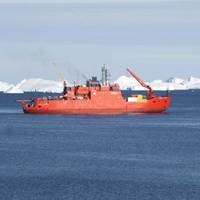
Australian Antarctic icebreaker Aurora Australis has departed Casey research station to return to Australia. The ship weighed anchor to leave Casey at 1,600 hours (AEDST) carrying summer personnel, scientists and cargo for return to Australia. The 52 passengers rescued from the Akademik Shokalskiy, who have been well-cared for on board during resupply, are looking forward to the trip home. The journey to Hobart will take approximately seven to eight days and Aurora Australis is expected to arrive in Hobart on or about January 22, about 14 days later than originally scheduled.
Weather Conditions Impact Antarctica Rescue
Adverse weather conditions have resulted in the Australian Antarctic Division (AAD) vessel Aurora Australis moving back into open water this afternoon. The area where the MV Akademik Shokalskiy is beset by ice is currently experiencing winds of up to 30 knots and snow showers. These weather conditions have resulted in poor visibility and made it difficult and unsafe for the Aurora Australis to continue today’s attempt to assist the MV Akademik Shokalskiy. Further attempts may be made by the vessel in due course to undertake the rescue once weather conditions improve. The Aurora Australis made it within 10 nautical miles of the MV Akademik Shokalskiy but is now located in open waters about 18 nautical miles east of the Russian vessel.
Antarctic Expedition Vessel Passengers to be Airlifted
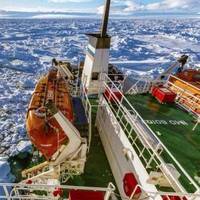
The latest news update from the Australian Maritime Safety Authority’s (AMSA) Rescue Coordination Centre (RCC Australia) informs that the Australian icebreaker 'Aurora Australis' is unable to reach the stranded 'Akademik Shokalskiy' as it would risk becoming beset itself if it continued with rescue attempts. Evacuation of passengers by helicopter is now planned. The Aurora Australis made attempts yesterday to reach the MV Akademik Shokalskiy but was driven back into open waters due to adverse weather conditions with winds up to 30 knots and snow showers causing poor visibility.
MV Akademik Shokalskiy Update
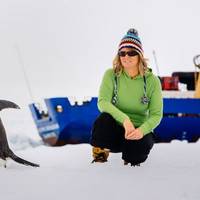
Rescue operations delayed by ice conditions. The Australian Maritime Safety Authority’s (AMSA) Rescue Coordination Centre (RCC Australia) has been advised this morning that sea ice conditions in the area are likely to delay today’s planned rescue of passengers from the MV Akademik Shokalskiy. It is now likely the rescue will not go ahead today. AMSA understands that current sea ice conditions prevent the barge from Aurora Australis from reaching the Chinese vessel Xue Long (Snow Dragon) and a rescue may not be possible today.
Update: Chinese Icebreaker Stuck After Rescue

According to a Reuters report, the Chinese icebreaker that helped rescue 52 passengers from a Russian ship stranded in Antarctic ice found itself stuck in ice on Friday, January 3, 2014. According to the Reuters report, Snow Dragon had ferried the passengers from the stranded Russian ship to an Australian icebreaker late on Thursday. It now had concerns about its own ability to move through heavy ice, the Australian Maritime Safety Authority (AMSA) said. The Australian icebreaker carrying the rescued passengers…
Chinese Icebreaker's Antarctic Response Gains Recognition
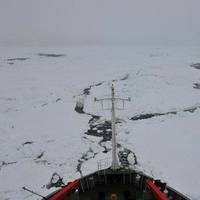
China’s research vessel and icebreaker 'Xue Long' has entered an area of clear water, after more than ten hours spent breaking up ice. A change in wind direction loosened the floes packed around the vessel, providing an 80-meter stretch of water for the Xuelong to navigate in, reports CNTV. The vessel's helicopter had earlier evacuated all 52 passengers from the stranded Russian ship Akademik Shokalskiy to the Australian icebreaker Aurora Australis. According to CNTV, the Australian Maritime Safety Authority…






